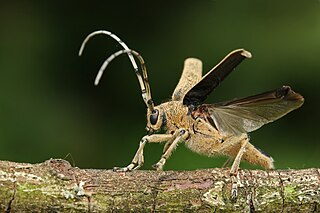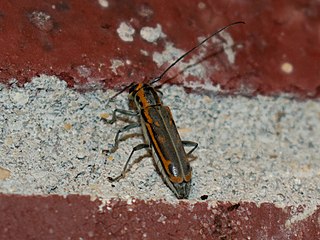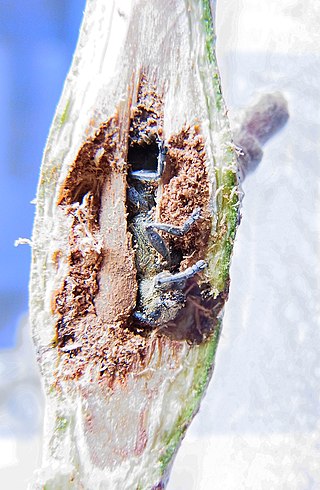
Horní Benešov is a town in Bruntál District in the Moravian-Silesian Region of the Czech Republic. It has about 2,200 inhabitants. Horní Benešov has a long mining tradition.

Bathybates hornii is a species of fish in the family Cichlidae. It is endemic to Lake Tanganyika where it forms schools and feeds mainly on clupeids. This species is apparently rather rare. It is little known and it is normally recorded from deep water during the day and moves towards the shorelines at night. The identity of the person honoured in this fish's specific name is uncertain but it is likely to be either, or both, of the Horn brothers, Adolf or Albin, who explored German East Africa and collected specimens for the Vienna Museum where the describer Franz Steindachner was curator of fishes.
Nasa hornii is a species of plant in the Loasaceae family. It is endemic to Ecuador. Its natural habitat is subtropical or tropical moist montane forests.

Dicerca is a genus of beetles in the family Buprestidae. It contains the following species:

Saperda carcharias is a species of longhorn beetle.

Saperda is a genus of flat-faced longhorn beetles belonging to the family Cerambycidae, subfamily Lamiinae. The genus was erected by Johan Christian Fabricius in 1775.
Saperda inornata is a species of beetle in the family Cerambycidae. It was described by Thomas Say in 1824. It is known from Canada and the United States. It feeds on Populus tremuloides.

Saperda candida, the roundheaded appletree borer, is a species of beetle in the family Cerambycidae. It was described by Johan Christian Fabricius in 1787. It is known from Canada and the United States. It contains the varietas Saperda candida var. bipunctata.

Saperda imitans is a species of beetle in the family Cerambycidae. It was described by Felt and Joutel in 1904. It is known from Canada and the United States.
Saperda interrupta is a species of beetle in the family Cerambycidae. It was described by Gebler in 1825. It is known from China, Russia, Siberia, Korea and Japan. It is associated with coniferous plantations, and infests species of fir, pine, spruce and other conifers.
Saperda lateralis is a species of beetle in the family Cerambycidae. It was described by Johan Christian Fabricius in 1775. It is known from Canada and the United States.

Saperda perforata is a species of beetle in the family Cerambycidae. It was described by Pallas in 1773, originally under the genus Cerambyx. It has a wide distribution in Europe. It feeds on Populus nigra, Populus alba, and Populus tremula. It is preyed upon by the parasitoid wasp Xorides indicatorius.

Saperda populnea, the small poplar borer, is a species of beetle in the family Cerambycidae which forms woody galls on twigs of poplars and willows. It was described by Carl Linnaeus in 1758.

Saperda quercus is a species of beetle in the family Cerambycidae. It was described by Charpentier in 1825. It is known from Turkey, Romania, Bosnia and Herzegovina, Jordan, Serbia, Bulgaria, Greece, Syria, and possibly Hungary. It feeds on Quercus coccifera.

Saperda scalaris is a species of beetle in the family Cerambycidae. It was described by Carl Linnaeus in 1758, originally under the genus Cerambyx. It has a wide distribution in Europe and Asia. It is preyed upon by parasitoid wasp species including Xorides praecatorius and Helcon angustator.

Bolbelasmus is a genus of beetles in the family Bolboceratidae. There are at least 20 described species in Bolbelasmus.
Geotrupes hornii, or Horn's earth boring beetle, is a species of earth-boring scarab beetle in the family Geotrupidae. It is found in the northeastern United States and southeastern Canada, most commonly between the months of June and September, peaking in August.
Dicerca hornii is a species of metallic wood-boring beetle in the family Buprestidae. It is found in North America.
Nemadus hornii is a species of small carrion beetle in the family Leiodidae. It is found in North America.
Ceylalictus is a genus of bees belonging to the family Halictidae. Type species is Ceylalictus horni(Strand, 1913), which was originally described as Halictus horni.











